Unit Vectors
What is a unit vector?
A unit vector is a vector with a magnitude (length) of exactly 1, pointing in a specific direction.
Any given direction (a line) contains infinitely many vectors of varying lengths, pointing either way along that line.
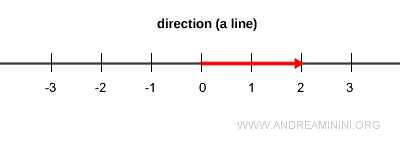
However, there is only one vector in that direction whose length is exactly one - the unit vector.
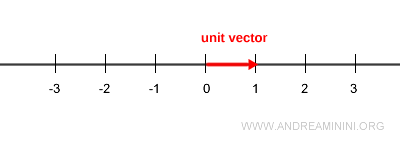
Why is it called a unit vector?
The term “unit” refers to its length - precisely one. It defines direction and orientation (sense) along a line.
What is a unit vector used for?
Any other vector in the same direction can be obtained by scaling the unit vector by a real number \( k \).
Example
Let \( \vec{v} \) be a unit vector.
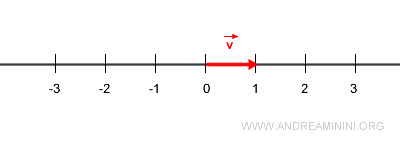
Suppose \( \vec{w} \) is a vector with magnitude 3.
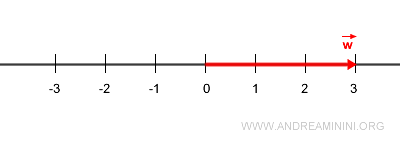
Then \( \vec{w} \) can be written as the product of \( \vec{v} \) and the scalar 3:
$$ \vec{w} = 3 \cdot \vec{v} $$
This yields a vector in the same direction as \( \vec{v} \), but three times as long.
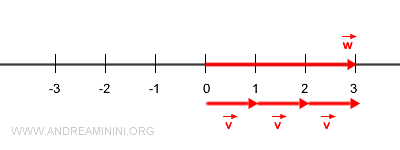
Example 2
Again, let \( \vec{v} \) be a unit vector.

Now, consider a vector \( \vec{u} \) of magnitude 2, pointing in the opposite direction.
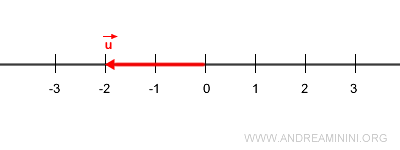
Note. The magnitude of \( \vec{u} \) is 2. It would be incorrect to say its magnitude is - 2: magnitudes are always positive. The sign indicates the direction relative to the unit vector.
We obtain \( \vec{u} \) by multiplying \( \vec{v} \) by - 2:
$$ \vec{w} = -2 \cdot \vec{v} $$
The negative scalar reverses the direction of the vector:
$$ \vec{w} = 2 \cdot (-\vec{v}) $$
Here, \( -\vec{v} \) is the opposite vector of \( \vec{v} \).
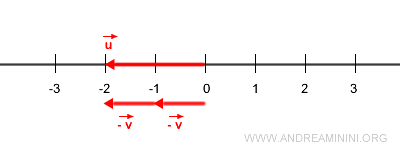
In short, once you have the unit vector, you can generate any vector along that line through scalar multiplication.
Unit Vectors Along the Coordinate Axes
Any vector in three-dimensional Cartesian space can be expressed as a linear combination of the unit vectors along the x-, y-, and z-axes: $$ \vec{w} = \alpha_1 \cdot \vec{u_x} + \alpha_2 \cdot \vec{u_y} + \alpha_3 \cdot \vec{u_z} $$
These unit vectors are commonly denoted \( \vec{u_x} \), \( \vec{u_y} \), and \( \vec{u_z} \), or simply \( \hat{i} \), \( \hat{j} \), and \( \hat{k} \).
The coefficients \( \alpha_1 \), \( \alpha_2 \), and \( \alpha_3 \) are scalars - real numbers.
Example
In two-dimensional space, we only need two unit vectors: \( \vec{u_x} \) and \( \vec{u_y} \).
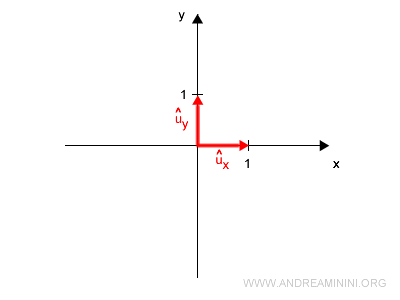
Note. For simplicity, we use the unit vectors of the canonical basis: $$ \vec{u_x} = \begin{pmatrix} 1 \\ 0 \end{pmatrix}, \quad \vec{u_y} = \begin{pmatrix} 0 \\ 1 \end{pmatrix} $$ Of course, any pair of linearly independent vectors in the space could serve as a basis.
The linear combination of these unit vectors can represent any vector in the space.
For example, to construct \( \vec{w} = (2,1)^T \):
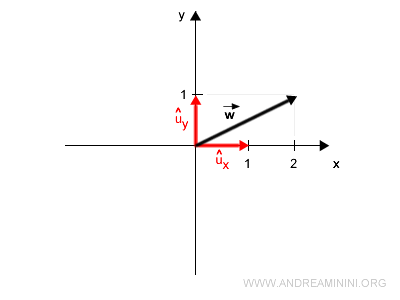
Note. The superscript \( T \) indicates the transpose - converting a row vector into a column vector: $$ \vec{w} = \begin{pmatrix} 2 , 1 \end{pmatrix}^T = \begin{pmatrix} 2 \\ 1 \end{pmatrix} $$
We express \( \vec{w} \) as:
$$ \vec{w} = \alpha_1 \cdot \vec{u_x} + \alpha_2 \cdot \vec{u_y} $$
with \( \alpha_1 = 2 \) and \( \alpha_2 = 1 \):
$$ \vec{w} = 2 \cdot \vec{u_x} + 1 \cdot \vec{u_y} $$
Substituting the unit vectors in component form:
$$ \vec{w} = 2 \cdot \begin{pmatrix} 1 \\ 0 \end{pmatrix} + 1 \cdot \begin{pmatrix} 0 \\ 1 \end{pmatrix} $$
Performing the scalar multiplications:
$$ \vec{w} = \begin{pmatrix} 2 \\ 0 \end{pmatrix} + \begin{pmatrix} 0 \\ 1 \end{pmatrix} $$
And summing the vectors gives:
$$ \vec{w} = \begin{pmatrix} 2+0 \\ 0+1 \end{pmatrix} = \begin{pmatrix} 2 \\ 1 \end{pmatrix} $$
Using this method, any vector in Cartesian space can be constructed from unit vectors.
And so on.
